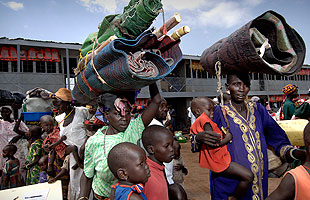Migration, Inundation… Top Scorers July 23, 2014
Author: Beach Combing | in : Contemporary, Modern , trackbackMigration – seasonal, circular, forced, permanent… – is as old as history. Folks from one community cross the river and go and live with folks on the other side. They work together, live together and eventually have children together. This stuff has been going on for tens of thousands of years. However, in modern times the rate of migration has grown by several factors and it is often typical in western countries, for around 10% of the population (legal and illegal) of a given country to be foreign born. The purpose of today’s post is to try and establish the largest immigrant influx in history anywhere.
The ground rules.
First, immigration suggests joining a host society: the occupation of, say, Indian territories in the New World must be ignored for the simple reason that Indian societies were practically destroyed and then segregated. There was no amalgamation until very late on, and then the Indians were – however unjustly – the migrants.
Second, thinking again of New World situations, the Pilgrim Fathers do not count as foreign born. They were a uniform cultural-ethnic group who had just shifted the boundaries of England to the west… Foreign born would refer to Portuguese or Danes coming to living among the early British colonials. In fact, the early English colonies had very few foreign immigrants in the sense meant here: particularly compared to their Dutch and French counterparts.
Third, for the purposes of this exercise migration must at least promise to be permanent: the vast migrant communities in the contemporary Gulf, for example, are temporary and shifting; the UAE has just under 84% foreign born population, but very few will die or marry in Dubai. Ditto the millions of Syrians who have, we must hope temporarily, fled to neighbouring states.
Fourth, it goes without saying that as important as numbers is migrant background: a Pole will integrate far more easily in Catholic Italy than a Somali, a Brit will, all things being equal, become ‘American’ more quickly than a Peruvian. But for the purposes of what follows only numbers matter.
Fifth, we are going to ignore, with apologies, very small countries: the Falklands, the Vatican City State…
Finding this data has proved difficult, at least, before the twenty-first century. However, a number of contenders stand out. First there are four Anglo-Saxon countries that began as emigrant magnets, who defined themselves as migrant states, and who have continued as magnets into the twenty-first century: the US, New Zealand, Canada and Australia. The US has today a mere ten percent foreign born population but in c. 1900 one in five Americans had been born abroad. The old British dominions have overtaken the US in this respect: 27.7% of contemporary Australians were born abroad. Wow. Second, you have a number of European countries that have gambled on massive migration: one in four Swiss residents were born outside the country; Austria has a 15% foreign-born population. Then, third, there is, of course, Israel that has had, at different times in its modern history, a majority foreign-born population: at least, if you follow some Israeli demographers, who often ignore, though, the Christian and Muslim Palestinian population. (The matter is very complicated, not least because large numbers of the Palestinian population are abroad, some having been born there).
These figures are overwhelmingly here and now. Surely there are more dramatic nineteenth century or even ancient instances? drbeachcombing At yahoo DOT com The problem with ancient population figures is, of course, that they are so damn unreliable.
In pure numerical terms, the crown probably goes to the US c. 1890, Australia now or, by certain definitions, Israel. However, if you want to put this all in a compressed time frame consider, instead, modern Ireland (not the six counties). In the early 1990s Ireland had practically no migrants save a loosely managed asylum seeker population and a sprinkling of the British leisured classes: then, from 1994 to 2008, Ireland was transformed as the country became, in a long decade, almost a fifth ‘foreign’ (best figures 17%): the free movement of migrants within the EU had allowed eastern Europeans to come and settle in the Republic. Consider too that the 2008 crash followed, and that very few migrants went home… It says a lot for the good sense and sanity of the Irish that the situation did not lead to riots: would their neighbours across the Irish Sea in John Bull’s other other island have been so level-headed? Whether the quintrupling of a migrant population in ten years was to be wished for is, of course, another question altogether…
24 July 2014: Norm writes: ‘As far as percentage, it was the Golden Horde, look any Ukrainian in the eyes and you see a bit of the Mongol looking back. Turkish is a Mongol language, Marco Polo describes the locals being cooked in bread ovens to the last man. The Han in China today are overrunning Tibet, again percentages, not shear numbers.’ I’d disqualify the first because of rule one above. As to Tibet numbers vary wildly. Chinese sources claim that there are three million Tibetans, Tibetans six million… Wow. Thanks Norm!



